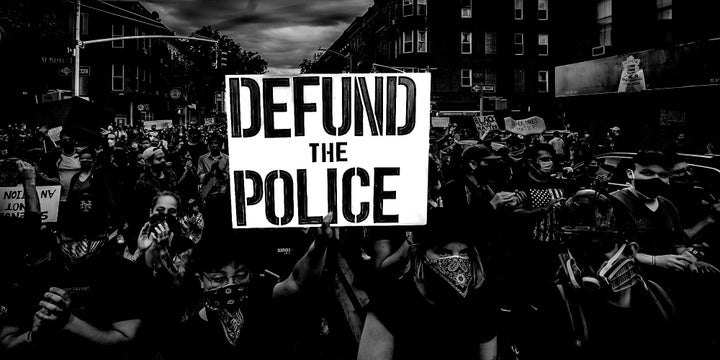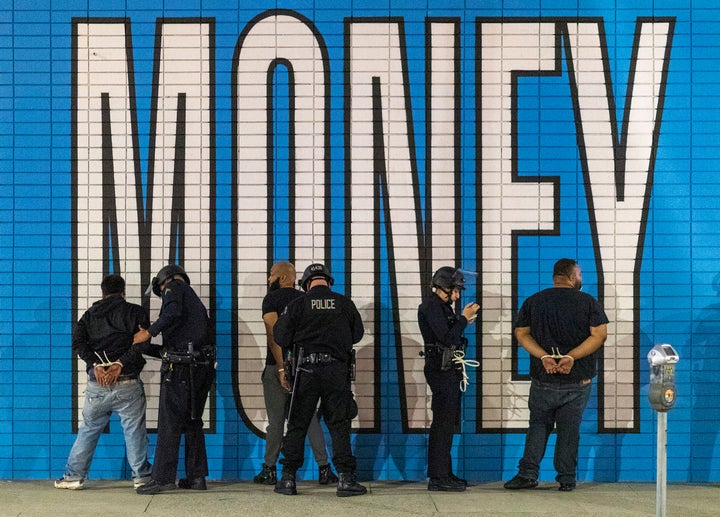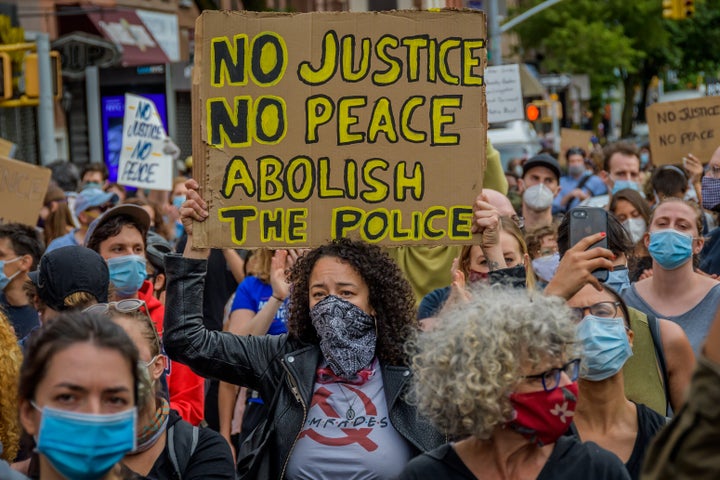
Chants to “Defund the police!” have reverberated around the country, from New York City to Minneapolis and through the streets of Los Angeles, as thousands of people protested racist police violence this past week.
While some may hear the phrase and assume it’s a radical, punitive step to end policing altogether, it’s actually an acknowledgment of a simple point: Police departments typically have way, way more money than other government services that could better serve communities without subjecting them to brutality and violence.
Collectively, the U.S. spends $100 billion every year on policing, or $1 trillion in the past decade. The New York City Police Department’s annual budget was nearly $6 billion last year. The federal Centers for Disease Control and Prevention’s annual budget for dealing with infectious diseases budget was about a third of that ($2.55 billion). The average state spending on higher education rose less than 6% between 1986 and 2013, while the average spending on policing increased by 141%, according to a 2018 Freedom to Thrive analysis.
Black Lives Matter and other anti-police violence groups have been working to defund the police by cutting agencies’ budgets for years. And these efforts have gained momentum in the wake of the outcries spurred by deaths at the hands of police of George Floyd, Breonna Taylor and others. Last year alone, police in the U.S. killed over 1,000 people, 25% of whom were Black.
“It is important to remember that modern-day policing have their roots in slave catching. These systems were created to hunt, maim, and kill Black people,” Kailee Scales, managing director of Black Lives Matter Global Network, told HuffPost. “As we have seen in the example of George and many others in this month alone, the police are a force of violence that profiles, harasses, and inflicts harm on Black communities without accountability ― and with far too many resources.”
“The police are a force of violence that profiles, harasses, and inflicts harm on Black communities without accountability ― and with far too many resources.””
- Kailee Scales, managing director of Black Lives Matter Global Network
Over the last decade, states and cities have spent more and more of their budgets on policing, far exceeding funding increases for other fundamental services like mental health care, affordable housing, job programs and education. Research shows that these services are actually more impactful in reducing crime than more police or prisons.
“We need and demand deep investment in education, employment programs, and real, meaningful and equitable universal health care,” Scales said. “We need to divest from police in (public) schools and invest in more teachers and counselors. We need to divest from the criminalization of mental health and provide mental health and restorative services.”
Floyd, who leaves behind five children, was arrested by police after a store owner accused him of buying cigarettes with a counterfeit $20 bill. Less than 20 minutes after police arrived, Floyd was unconscious on the ground, as police officer Derek Chauvin knelt on his neck for nearly nine minutes. Whether the $20 bill was fake has yet to be confirmed by authorities. Floyd recently lost his job at a restaurant due to the coronavirus outbreak, and a variety of city services might have helped him. The police didn’t.
Massive Police Budgets Across the Nation
Although budgets for policing exist on the federal and state levels, the majority of funds spent on policing come from local municipalities. The majority of that money comes from tax revenue from the public, but other revenue streams include state funding, federal funding and private donations from police foundations, the latter of which is often not disclosed. These funds pay for police buildings, vehicles, officers’ and other police employees’ salaries, and more.
Oakland, California, spent over 40% of its total budget on its police department in 2018, according to a 2018 Freedom to Thrive report published by the Center for Popular Democracy, Law for Black Lives and the Black Youth Project. Los Angeles and Chicago have some of the largest police budgets in the country, both topping out at nearly $1.5 billion in 2018 (L.A.’s police budget accounted for 25% of its total budget, while Chicago’s accounted for nearly 40% of its overall budget). In Minneapolis, where Floyd was killed, 35% of the city’s 2018 budget went to the police department.
Police budgets seem even more gargantuan when compared to the budget for other social services in cities. In 2019, the New York City Police Department had a budget of nearly $6 billion, which is around 8% of the city’s total budget. The total annual budget for job programs was around $281 million ― 0.3% of the city’s budget. In Oakland, social service programs like youth programs, housing and income support received less than 30 cents to every dollar given to the police in 2018.
The disparity in funding between police departments and other human services was on full display when hospitals and doctors across the country were scrambling to find personal protection equipment, ventilators and intensive care unit beds as the coronavirus spread across the U.S. in March. Two months later, police turned out in military-grade equipment to respond to protests and rioters.

“The United States did not have to be the country that had the highest number of [coronavirus] cases and deaths in the world,” said Kumar Rao, co-author of the Freedom to Thrive report and director of Justice Transformation at the Center for Popular Democracy. “The reasons for that are complex, but at least one of them is the fact that we did not invest in public health in this country in the way that other countries do. The issue of how we spend our money is a really, really important one.”
In some cities, police budgets are used to pay out police misconduct settlements. Chicago spent $113 million in 2018 alone to settle lawsuits alleging police misconduct; in the past decade, the city has paid out more than $500 million in such settlements. Between 2005 and 2018, Los Angeles paid out a total of $880 million in settlements.
While it’s important that the families of Eric Garner, Ezell Ford and so many more receive monetary justice for police brutality that took their loved ones from them, this money often comes from taxpayers. What’s more worrisome is that police brutality has no direct financial implications for the departments ― even after highly publicized killings, their budgets keep growing.
Meanwhile, the “government continues to sell us this false narrative that we don’t have enough money” for other services like healthcare, education, housing or substance abuse programs, Rao said. “It’s austerity for everything but the military and the police.”
“In this nation, city budgets illustrate where its priorities lie,” Scales said. “It is time for divestment from violent policing infrastructure and investment in strengthening Black communities. And we can no longer wait.”
Challenging The Idea That More Police Mean Better Safety
In order to understand why cutting police budgets is beneficial, the country first has to fundamentally shift its approach to and understanding of the police as an American institution. Overpolicing does not actually keep communities safe, said Saye Joseph, policy and advocacy manager at Black Youth Project 100.
“Police, in all forms, have been a way to keep property safe and keep a subsection of society safe but it hasn’t kept all communities safe and healthy,” Joseph said. “We have to break that notion apart that police equals safety.”
Oftentimes, the very services underfunded by cities become baked into police officers’ jobs.
“We over-rely on police to handle a range of social problems that they are simply incapable of addressing,” Seth Stoughton, a former police officer and current associate law professor at the University of South Carolina, said. “They don’t have the expertise, the training, the equipment, the organizational capacity to deal effectively with mental illness or poverty, homelessness, substance abuse, school discipline ― a whole range of things that we socially have made police issues.”
By reallocating parts of massive police budgets back into communities, specifically communities of color, the “constant clarion call for more officers” may begin to lose its appeal, Stoughton added.
While some organizers have called to fully abolish the police (and many have said that defunding the police is the first step in doing so), Stoughton urged caution. He fears that if the police as an institution is fully eradicated, private security will simply take their place. Privatized security would most likely have less oversight, less training and less professionalism than the police departments we have now.

The George Zimmermans and Travis McMichaels of the world, Stoughton cautioned, could become the people employed by private security entities. (Zimmerman, the head of his neighborhood watch in a Florida community, fatally shot Trayvon Martin while the 17-year-old was walking in a hoodie because Zimmerman thought Martin looked suspicious; McMichaels is charged with killing Ahmaud Arbery in Georgia after McMichaels and his father believed Arbery was a robbery suspect, chased him in a pickup truck and shot him while he was out for a jog; the father and another man also have been charged in the case.)
“If we scrapped police agencies, what may happen is we’re going to see more gated neighborhoods that hire their own armed security forces. That doesn’t seem like a tenable solution to me,” Stoughton said. “At its core to me, policing is a public service. It is and primarily should be a government institution, which shouldn’t be limited to the relatively few wealthy enclaves that can afford to provide it in whatever way they want.”
What Does Defunding The Police Actually Look Like?
Some cities and localities have already taken steps to stop inflating police budgets. Last year, Jillian Johnson, the mayor pro tem of Durham, North Carolina, decided not to allocate more funding to city police officers.
“Like every other community in America, our community is over-invested in policing and incarceration and under-invested in housing, jobs, education, health and all the other investments that make those punitive interventions unnecessary,” she wrote at the time. “The safest communities don’t have the most cops; they have the most resources.”
In 2018, St. Paul, Minnesota, Mayor Melvin Carter rejected a request for more police officers. “Our driving goal shouldn’t be to hire as many officers as possible but to reduce the number of times we have to call police in the first place… As long as we focus more on responding to emergencies than on preventing them in the first place, we’ll never have enough police officers,” he said at the time.
“Budgets are a really clear way for cities to shrink the size, the scope and the power of policing.”
- Kumar Rao, director of Justice Transformation at the Center for Popular Democracy
Photos of militarized police assaulting peaceful protesters during the current unrest have led some city officials to question if the police really need this much money and firepower. Los Angeles Mayor Eric Garcetti has been pushing for a 7% overall increase in the city’s police budget. But on Wednesday, Garcetti said he will cut up to $150 million in the LAPD’s budget to invest “in jobs, in health, in education and in healing,” especially in the city’s communities of color.
In a significant move, the Minneapolis school district terminated its contract with the city police department because of Floyd’s death.
Few other cities have embraced the idea of cutting police budgets. New York City Mayor Bill de Blasio’s 2021 spending proposal would keep the NYPD’s nearly $6 billion budget mostly intact while cutting funds for other agencies and programs ― some by as much as 80% ― in the wake of the pandemic’s effect on tax revenues. In Philadelphia, the mayor has proposed spending $977 million on police and prisons, while cutting funding for employment development, recreation centers, libraries and youth violence prevention.
President Donald Trump, whose desire earlier this week for a photo-op resulted in law officers using tear gas, rubber bullets and flash-bang grenades to disperse peaceful protesters outside the White House, has criticized demands to defund the police.
“The Radical Left Democrats new theme is ‘Defund the Police.’ Remember that when you don’t want Crime, especially against you and your family,” he tweeted. “More money for Law Enforcement!”
Although mayors and other elected officials control the purse strings for their law enforcement agencies, they’re not really in control right now, said Rao of the Center for Popular Democracy.
“Part of the reason city officials are in this position is because they have given so much money and power over to police departments, year after year,” he said. “That needs to fracture in order for us to be able to plot a new path forward. Budgets are a really clear way for cities to shrink the size, the scope and the power of policing.”
CORRECTION: An earlier version of this article misstated that the 2019 New York City Police Department budget was nearly $7 billion, which is the combined budget for corrections and police. The article has been updated to include the correct 2019 budget for just the New York City police, which is nearly $6 billion.
